Commander Legends is almost upon us, promising a phenomenal set of cards both new and old. Set reviews are not really my thing, but if there’s one thing that my playgroup knows me for, it’s intensely flavorful deckbuilding. So today, I’ve got a blend of a quick lore and a Commander deck to share with you—one of my favorite flavor decks and also the first EDH deck I ever built: Serra Tribal. Put on your Sunday best, friends, because we’re going to church.
Angelology
Ever since Homelands, I have been enchanted by the story of Serra. Initially, the planeswalker’s namesake Serra Angel stood alone with the likes of Sengir Vampire and Shivan Dragon as the sole references to now famous characters and locations. We glimpsed the Cathedral of Serra in Legends—don’t worry, it gets better—and saw her influence more fully in Homelands and Weatherlight. But it wasn’t until Urza’s Saga that we finally met the planeswalker and her plane on cards such as Worship, Serra’s Sanctum, and the basic plains from that set. Serra’s story was tragic and compelling.

Plains (Urza’s Saga) by Rob Alexander
An incredibly powerful planeswalker, Serra created an artificial plane of Drifting Meadows and floating citadels where her followers could live in peace, watched over by her angels. During the events leading up to the Phyrexian Invasion, her plane was discovered by the Phyrexians when Urza fled there to recover. Because of the taint of black mana that now grew in her realm, Serra could no longer bear to remain. Serra was force to abandon the plane, proposing her followers join her in a mass exodus, but leaving Radiant—one of the first archangels Serra ever created—as the realm’s caretaker.
As the years passed, Radiant’s mind was taxed by the burden of Serra’s throne, and poisoned by the whispers of Phyrexian sleeper agents posing as her advisors; turning her against her own people even as the taint of black mana and the lack of Serra’s sustaining magic were causing the plane to collapse. Using the Weatherlight, Urza intervened to evacuate all of Serra’s Realm’s people who wished to flee, finally pulling Radiant and the collapsed plane into the Weatherlight’s powerstone, where they yet remain.
Serra’s followers found a new home near Epityr, in what would one day be called Benalia. In the meantime, Serra herself found a home on Ulgrotha with the planeswalker Feroz, with whom she fell deeply in love. Serra founded the state of Aysen, and the people of the state revered her as a goddess. When Feroz was killed in an accident, Serra left the Homelands of Ulgrotha for Dominaria. Finding herself among refugees and still reeling from grief, when attacked by a bandit, Serra chose to give her life as a consecration of the land rather than heal herself—channeling all of her white mana into Sursi, blessing the land and protecting its inhabitants, to the extent that angels still come into being there as answers to the prayers of the Serran faithful.
May Angels Lead You In
The idea of angels and paladins fighting to protect the weak always appealed to me as a child. As I began to study religion, Magic’s most positively portrayed religion resonated with my own best experiences of my own faith tradition. So of course, when I returned to Magic in 2018 after a long break and discovered Commander, a deck based on the Church of Serra was a natural first deck to build!
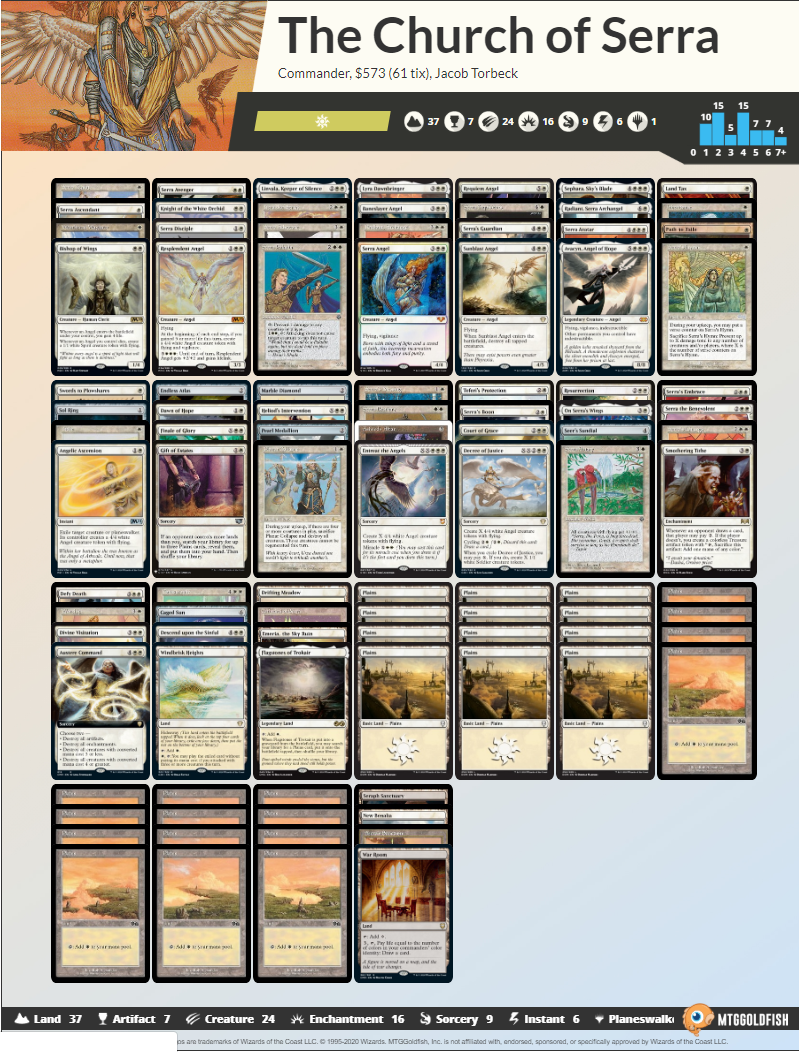
The decklist has grown and changed over the past couple of years, as new cards have been released and I’ve become a better deck builder, but one thing has remained constant: every mono-white card with Serra in its name. In addition to the newly printed Radiant, Serra Archangel, Commander Legends has added a pair of new boons for this deck: War Room and Court of Grace, which will help us keep cards in our hand and creatures on board.

This deck is helmed by original Radiant—a 3/3 Legendary Angel with Flying and Vigilance who gets +1/+1 for each other flying creature in play (even those our opponents control). Radiant doesn’t enable any sort of engine, but can become a major threat once we start producing Angel and Spirit tokens, sometimes striking down an opponent with one blow if we can resolve Finale of Glory for 10 with Divine Visitation on board.
Hark! The Herald of Serra Sings
The conceit of this deck is to represent the Church of Serra by playing every white card with Serra in the name. Alas, poor Serra Sphinx has to sit this one out. This voluntary limitation sticks us with some wonderful cards, like Serra’s Sanctum and Serra Ascendant, but mostly middling to terrible cards as far as EDH goes.
Even these terrible cards, however, can impact the game in some unexpectedly great ways. They mess with your opponents’ threat assessment—Cathedral of Serra can utterly confound opponents who have no idea that banding can be “good, actually.” A host of underpowered creatures can leave you unattended while you prepare a haymaker. Plus, people really enjoy seeing some of these themed cards hit the table that they’ll probably never see in any other deck, and that’s a whole lot of fun.
Planeswalker: Serra the Benevolent
Lands: Cathedral of Serra, Serra’s Sanctum
Creatures: Herald of Serra, Radiant, Serra Archangel, Serra Advocate, Serra Angel, Serra Ascendant, Serra Avatar, Serra Avenger, Serra Inquisitors, Serra Paladin, Serra Zealot, Serra’s Guardian
Enchantments: On Serra’s Wings, Serra Aviary, Serra Bestiary, Serra’s Blessing, Serra’s Boon, Serra’s Embrace, Serra’s Hymn, Serra’s Liturgy

Serra Angel by Rebecca Guay
The Better Angels of Our Nature
Waiting in the wings are a heavenly host of much better creatures and spells that can help us soar to victory. We’d never be able to compete with an optimized deck head to head; but in a game where we fly under the radar, resolving the right combination of these spells can give us a board state that will have our opponents praying for an answer.
Whether it’s Avacyn, Angel of Hope or Sephara, Sky’s Blade granting our choir indestructibility; Lyra Dawnbringer granting them lifelink; or Linvala, Keeper of Silence shutting down the opponents’ activated abilities; our angels will turn every eye heavenward when they hit the battlefield. Be prepared to lose a few.
Defy Death and Resurrection offer us thematic recursion. If an opponent attempts to turn one of our guardians against us, using Angelic Ascension on our own creature beats letting them have our Avacyn. After numerous games where Radiant, Archangel has turned traitor, I’m considering adding Homeward Path as well.
Rounding out the Altos, Sunblast Angel can punish overzealous opponents who lack Serra’s Blessing, and Resplendent Angel can churn out additional angels in the midgame. Baneslayer Angel is a solid body that will sometimes draw removal, but she’s one to consider subbing out for something else that better fits in your metagame.
Halos, Harps, and Angelic Accoutrements
Every commander deck needs a few basic ingredients: a solid mana base, ample ways to ramp and achieve card advantage, and ways to answer threats. Let’s start with removal and work our way backward.
White has some of the best removal in the game: Swords to Plowshares and Path to Exile are auto-includes, and we’re also running Angelic Ascension and Serra Bestiary for flavor reasons. Angelic Ascension’s flexibility as being able to exchange one of our own smaller creatures for 4/4 angel has come in exceedingly handy in the past, but exiling a combo piece or value engine can be just as worthwhile. Heliod’s Intervention has fantastic flexibility; and Serra Liturgy, while slow, can go unnoticed and surprise inattentive opponents.
When it comes to mass removal, intensely flavorful choices like Planar Collapse and Catastrophe run alongside the still-thematic Austere Command, Descend upon the Sinful, and Sunblast Angel. In my maybe-board is the somewhat contentious Winds of Abandon; ramping our opponents is often ill-advised, but the powerful effect can have upside in a deck like this.
The deck includes standard choices for card advantage and ramp. Weathered Wayfarer, Knight of the White Orchid, Land Tax, Tithe, Gift of Estates, Sol Ring, Pearl Medallion, Marble Diamond, Smothering Tithe, Caged Sun, and Serra’s Sanctum offer a wide variety of ways to hit the coveted 12-mana mark. This deck could substitute Arcane Signet for Marble Diamond, and maybe I’ll get around to that in my next round of updates. Oketra’s Monument is also worthy of consideration, and if you have it, a Mana Crypt can’t hurt, right?
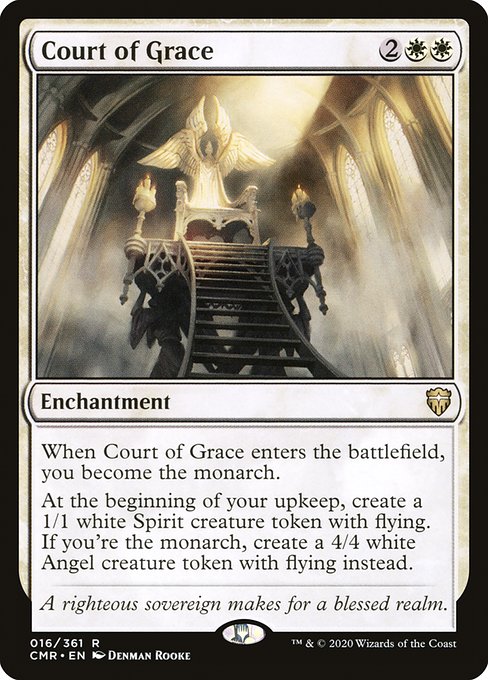
As far as card advantage is concerned, Endless Atlas, Seer’s Sundial, Inheritance, Dawn of Hope, Defy Death, Resurrection, and Emeria, the Sky Ruin will be familiar to players of mono-white. War Room and Court of Grace give us two new ways to draw cards, though we must be wary not to leave ourselves too open lest we become the monarch only to have someone else steal the crown.
Our manabase otherwise is 37 lands, 28 of which are basic plains—important for cards like Emeria and Endless Atlas. We most definitely want to use thematic lands here, because putting down this panorama is just gorgeous:
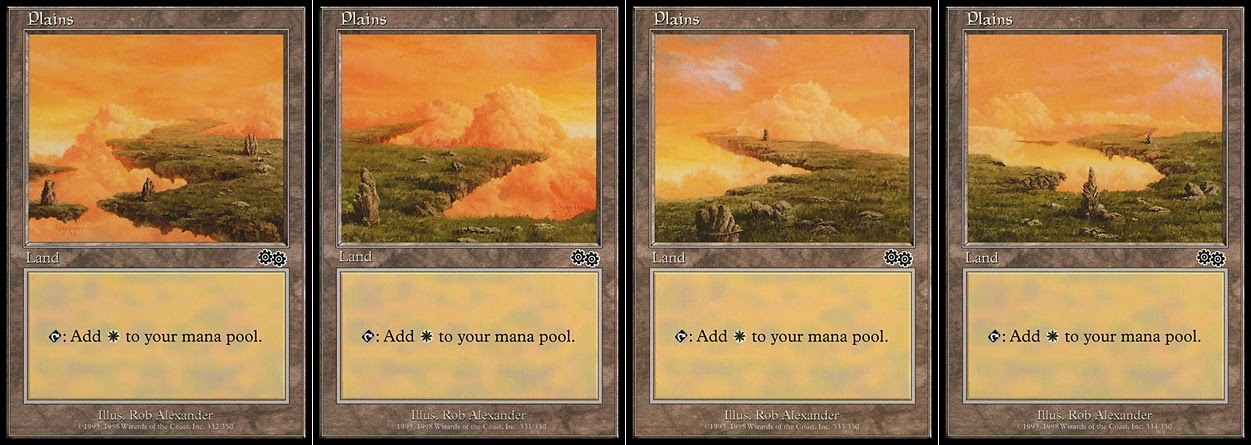
Plains (Urza’s Saga) by Rob Alexander
And the Dominarian plains offer a wonderful compliment to represent how the memory of Serra’s Realm has lived on in the Church’s architecture:
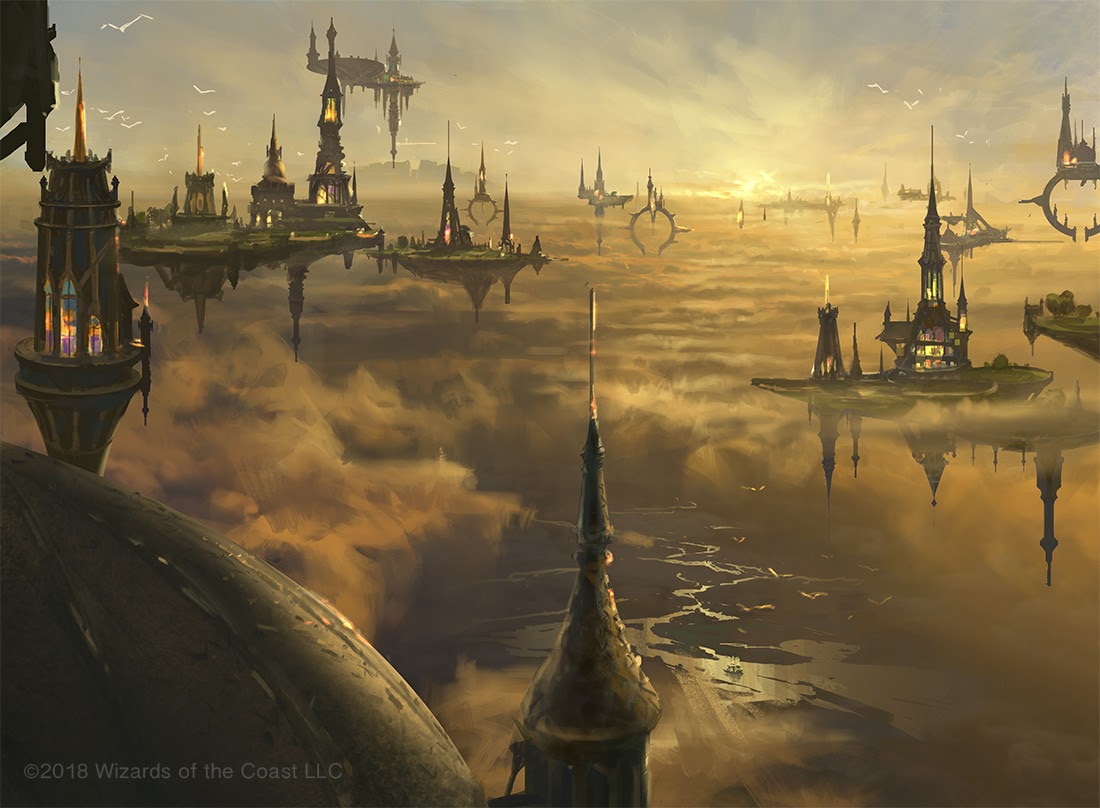
Plains (Dominaria) by Dimitar Marinski
Take Me to Church
While this deck is mostly about reveling in its theme, there is a way to “go infinite” as regards tokens, mana, life, card draw, and, with some substitutions, direct damage or mill. By resolving Bishop of Wings, Divine Visitation, and a sacrifice outlet like Ashnod’s Altar, we can essentially generate an infinite amount of life and whatever our sacrifice outlet wants to make. With Ashnod’s Altar, we can generate infinite colorless mana to sink into a host of outlets. If you have one, Phyrexian Altar might be a worthy substitution so you can ensure you have enough colored mana to cast any spell with the resulting mana.

Want to create an infinitely large Radiant, Archangel? Sink that mana into Finale of Glory or Decree of Justice. The life gain Bishop of Wings nets us when angels come into play triggers Dawn of Hope, and the mana generated by the altar can pay for the card draw. If we do not have Dawn of Hope, we can use every second or third sacrifice to pay for Inheritance when our token is sacrificed. By adding Requiem Angel to the battlefield, we now create two angels when we sacrifice one, doubling our angels every time and making our commander totally massive.
Infinite mana, life, angels, and card draw are divine contributions to our very straightforward win condition: use an army of angels to push Radiant to at least a 21/21, and swing for lethal commander damage, hoping to get a second swing on the following turn. Such a straightforward, combat-based win condition is obviously most suited for lower-power tables. Even in more optimized company, there are times when opponents just don’t draw the relevant removal, or are so busy using it on one another that we emerge the victor.
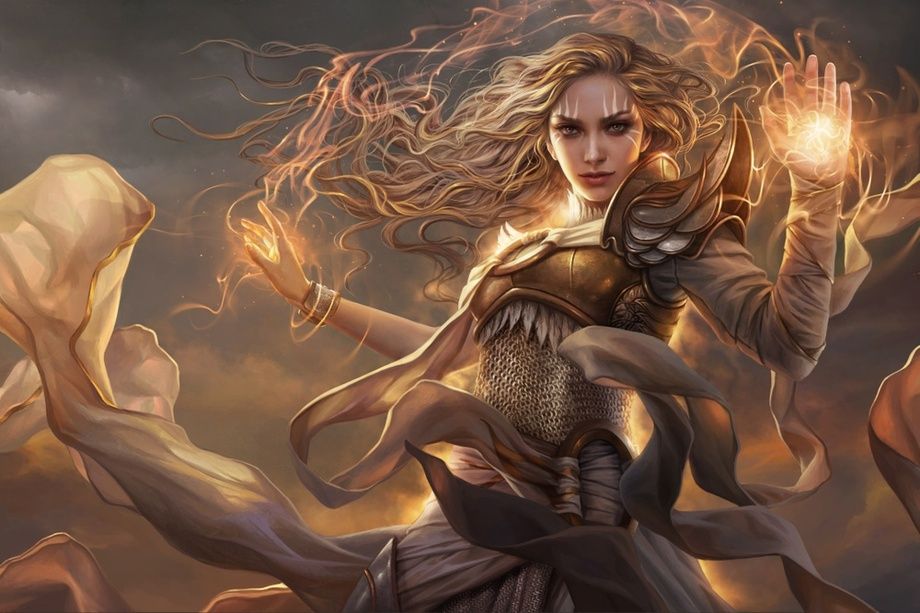
Modern Horizons key art (Serra) by Magali Villeneuve
“Ite, missa est”
Imposing flavorful restrictions on myself is one of my favorite ways to brew a new deck. As with my maps deck, trying to make a core subset of suboptimal but super neat cards function in a way that still leads to fun games can be an enjoyable challenge. It also leads to other people enjoying the experience of seeing unexpected or otherwise unplayed cards, and learning something about the deckbuilder.
With this Serra tribal deck, I get to express my longstanding affection for Serra and her angels and my passion for religions (which I love so much I work as an academic theologian) while looking at numerous gorgeous cards illustrated by Rebecca Guay (a favorite of mine) and going wide with flights of heavenly warriors. What are the flavorful builds you’ve made or are planning? With the newly printed Sengir, the Dark Baron, is a Sengir-themed deck in the offing? Have you built an old-school Weatherlight crew deck with Sisay?
Let me know on social media, and until next time, enjoy this Serra-themed playlist I put together for the occasion:
Recommended Listening:
The Magic Story Podcast, Episode 17: The Church of Serra
Jacob Torbeck is a researcher and instructor of theology and ethics. He hails from Chicago, IL, and loves playing Commander and pre-modern cubes.

